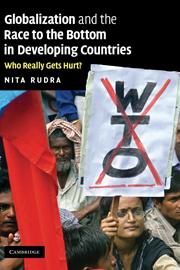Book contents
- Frontmatter
- Contents
- List of figures
- List of tables
- Preface
- 1 Introduction
- 2 The race to the bottom in developing countries
- 3 Who really gets hurt?
- 4 LDC welfare states: convergence? What are the implications?
- 5 Globalization and the protective welfare state: case study of India
- 6 Globalization and the productive welfare state: case study of South Korea
- 7 Globalization and the dual welfare state: case study of Brazil
- 8 Conclusions
- Appendix A LDC social spending
- Appendix B Assessing potential labor power
- Appendix C Additional tests for the RTB hypothesis
- Appendix D Variables in the inequality model
- Appendix E Technical notes on Gini coefficients
- Appendix F LDC Gini coefficient statistics
- Appendix G Robustness check
- Appendix H Conditional impact of trade on inequality
- Appendix I Descriptions and sources of variables
- Appendix J Cluster results minus outcome variables
- Appendix K Dendrogram for cluster analysis
- Appendix L Poverty tables
- Appendix M Social expenditures on social security, health, and education in India (percent of GDP) based on national data
- References
- Index
5 - Globalization and the protective welfare state: case study of India
Published online by Cambridge University Press: 22 September 2009
- Frontmatter
- Contents
- List of figures
- List of tables
- Preface
- 1 Introduction
- 2 The race to the bottom in developing countries
- 3 Who really gets hurt?
- 4 LDC welfare states: convergence? What are the implications?
- 5 Globalization and the protective welfare state: case study of India
- 6 Globalization and the productive welfare state: case study of South Korea
- 7 Globalization and the dual welfare state: case study of Brazil
- 8 Conclusions
- Appendix A LDC social spending
- Appendix B Assessing potential labor power
- Appendix C Additional tests for the RTB hypothesis
- Appendix D Variables in the inequality model
- Appendix E Technical notes on Gini coefficients
- Appendix F LDC Gini coefficient statistics
- Appendix G Robustness check
- Appendix H Conditional impact of trade on inequality
- Appendix I Descriptions and sources of variables
- Appendix J Cluster results minus outcome variables
- Appendix K Dendrogram for cluster analysis
- Appendix L Poverty tables
- Appendix M Social expenditures on social security, health, and education in India (percent of GDP) based on national data
- References
- Index
Summary
The following three chapters illustrate the findings from the previous portion of the book by selecting one representative from each cluster: a protective welfare state (India); a productive welfare state (South Korea); and a weak dual welfare state (Brazil). These case studies are intended as heuristic devices, rather than another hard test of the hypotheses in this book. The purpose of the case illustrations is to provide a more nuanced and detailed look at the primary research finding: as international market demands systematically affect government policy decisions in developing countries, distinct institutional arrangements governing the distribution of welfare persist and, as a consequence, middle-class labor groups are the ones most directly hurt by race to the bottom pressures. The country overviews essentially provide greater in-depth analysis of how national social policy configurations are structuring responses to globalization. The addition of the case study analysis allows a more applied understanding of the consequences of globalization in terms of cutbacks (RTB) and institutional changes. In addition, they permit consideration of the role of other factors not emphasized in the quantitative analysis, such as democracy.
One caveat should be kept in mind as the case studies unfold in the following chapters. Because the causal linkages have been empirically verified in the earlier chapters, I take on the broad panorama of each country's political economy and related social welfare strategies in a swift, bold, and unrestrained manner.
- Type
- Chapter
- Information
- Globalization and the Race to the Bottom in Developing CountriesWho Really Gets Hurt?, pp. 108 - 141Publisher: Cambridge University PressPrint publication year: 2008

